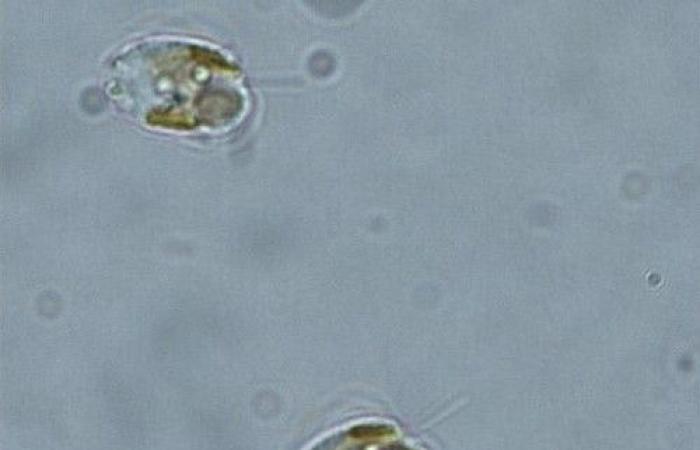8/21/2022
Scientists from the Leibniz Institute for Freshwater Ecology and Inland Fisheries (IGB) and the University of Vienna consider natural causes for the mass development of algae to be unlikely
The latest investigations confirm the suspicion that the mass development of a toxic brackish water alga has taken place in the Oder. This could have played a role in the massive deaths of fish, mussels and snails and possibly other animal species. The researchers still do not assume a purely natural phenomenon, because the algae species Prymnesium parvum does not occur in large numbers on the affected sections of the Oder under natural conditions. For mass occurrence in this area, it is dependent on salinity, which can only be caused by industrial discharges. The Leibniz Institute for Freshwater Ecology and Inland Fisheries (IGB) had detected and microscopically identified the toxic brackish water alga in all samples from the middle Oder over the past few days, but the associated algal toxin had not yet been proven. Expert Elisabeth Varga from the Institute of Food Chemistry and Toxicology at the University of Vienna analyzed the IGB samples and was able to confirm the assumptions about the algal toxin.
“We were able to detect a subspecies of the algal toxin, the so-called ‘Prymnesine’, without any doubt and actually in significant quantities in samples from the Oder from different locations,” explains scientist Elisabeth Varga from the University of Vienna, who carried out the analyzes there at the mass spectrometry center. “We know from previous research results on this algal toxin that the toxin is strongly bound to the alga itself. If this specific type of algae is present in very large quantities, as is the case in the Oder samples, a very high concentration of the toxin must also be assumed. Since all samples were taken in the advanced stage of the algal bloom, a direct connection with the death of fish and molluscs can be assumed,” explains Elisabeth Varga. However, there is still a fundamental need for research on the toxicity of prymnesins; it has not yet been conclusively clarified which groups of organisms other than fish and molluscs could be affected. This also applies to potential effects on the human organism.
The exact quantity determination from the biomass samples of the alga itself and the water samples taken is currently in progress, but it is technically and time-consuming. “Prymnesins are very specific organic compounds, as far as is known, with up to 107 carbon atoms. In principle, these can be measured with modern mass spectrometers, but in practice they are only analyzed in a few laboratories in Europe, also because they are not searched for,” explains Stephanie Spahr, head the IGB working group on organic pollutants. Since there are no analytical standards for these toxins available anywhere in the world, they were clearly assigned using previously characterized strains that were cultivated as part of international projects at the University of Copenhagen (Per J. Hansen working group) and at the Danish Technical University (Thomas O . Larsen) have been characterized.
“The Oder is currently experiencing an extreme mass development of planktonic algae. Prymnesium parvum is very dominant in all samples, in the Oder the alga accounts for at least half of the total algal biomass, even after dilution by the inflow of the Warthe it is still 36 percent. Such a one To my knowledge, mass development has never been observed in our waters. It was probably made possible by salt discharges, plenty of nutrients, high water temperatures and long residence times in barrages and in the developed river,” emphasizes IGB scientist Jan Köhler, head of the Photosynthesis and Algae Growth working group and macrophytes.
“Now the genetic characterization of the algal strain is still missing. More than 50 strains of Prymnesium parvum have been described, which differ greatly in their environmental requirements and toxin production. The toxins are currently grouped into three groups, with each group consisting of more than 10 different toxins , which poses a major challenge in determining it,” explains Jan Köhler.
“We are now also getting in touch with the responsible authorities immediately so that the research results can be integrated into new measurement campaigns and programs,” explains IGB scientist Tobias Goldhammer, head of the nutrient cycles and chemical analysis working group. In this way, the further development on the Oder can be better followed. “The increased salt levels that we measured in the samples occur more often in the Oder, they are promoted by industrial pollution in the upper reaches. In this respect, if the salt concentrations do not fall and we continue to experience hot and dry summers, it could increase again in the future such toxic mass developments,” emphasizes Tobias Goldhammer.
Article put online by: / Doris Holler /
Tags: Fish deaths Oder Algae poison brackish water species detected Oderwasser


